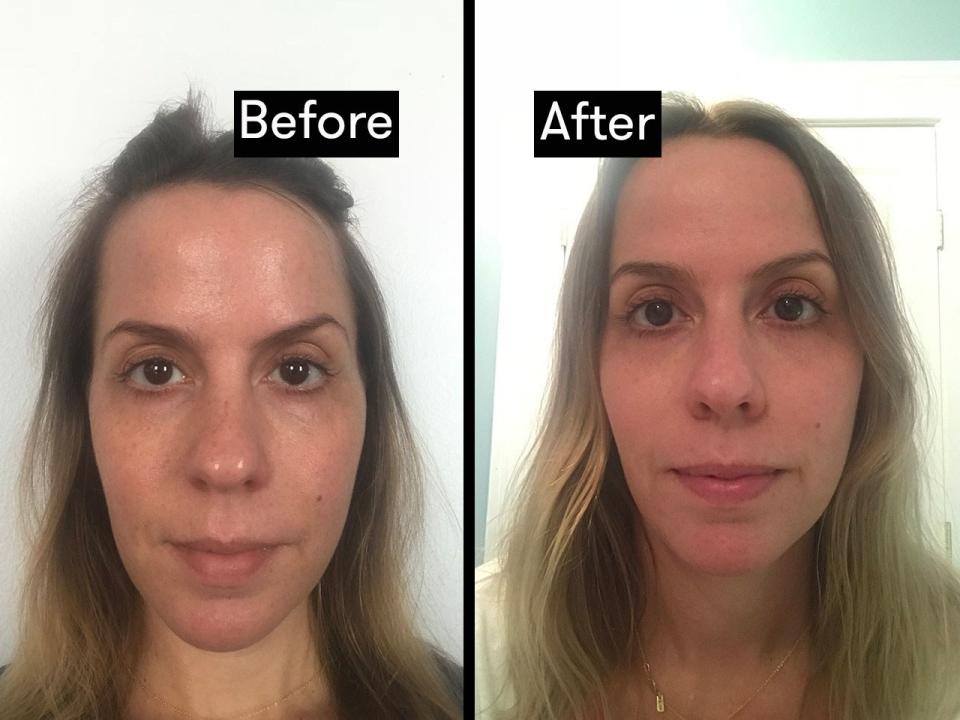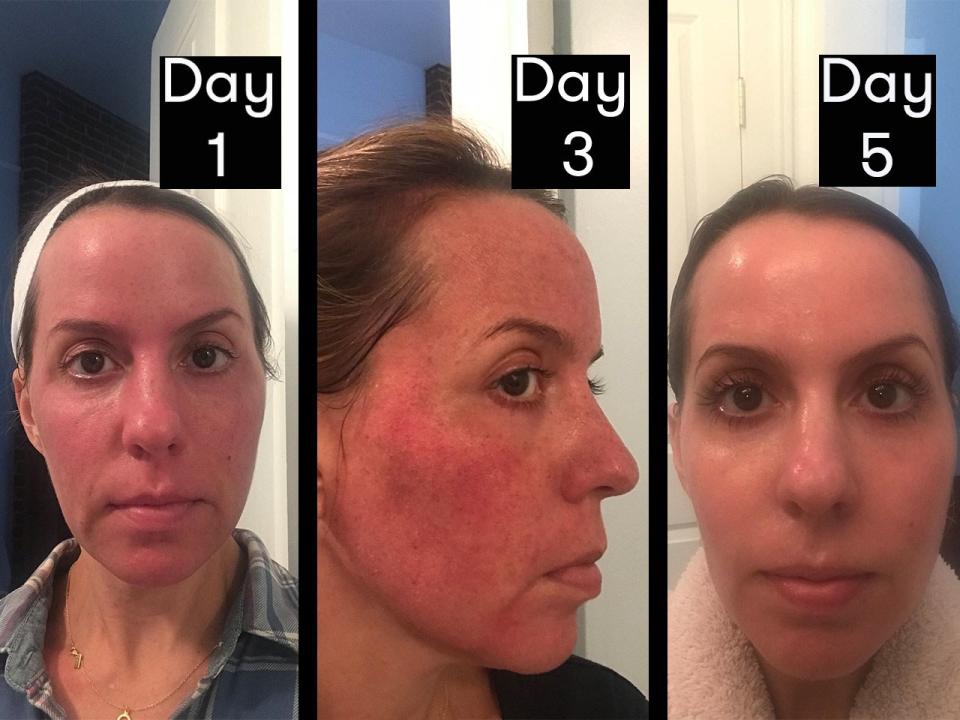What It’s Actually Like to Get Fraxel Laser Treatment
My dad owned a tanning salon when I was a kid. I was his first employee and got a quarter for cleaning each bed after use. When his business when bankrupt, we lugged one of the old tanning beds to our garage and I got free reign to bake myself as I pleased. This kind of recreational activity gave me the desired orangey-bronze skin tone I sought for homecoming photos, but caused serious repercussions.
At the age of 39, I have sun damage and am mercilessly backpedaling with obsessive SPF application and an increasingly complicated skin-care product regimen. But when I am occasionally being carded for wine, I give most of the credit to Fraxel laser treatment.
Fraxel is an FDA-approved laser device dermatologists use treat the signs of aging in the skin, such as fine lines, wrinkles, scarring, and sun damage (or age) spots. Doctors laud its results and the minimal downtime required for healing. It doesn’t come cheap; treatment often costs about $1,000 a pop. (Solta Medical, the company that makes Fraxel lasers, says patients will have noticeable improvements immediately but recommends three to five as “an effective treatment regimen.”)
During my first treatment, ten years ago, I wasn’t at all concerned about fine lines or wrinkles. I had melasma on my upper lip—what I referred to as my Burt Reynolds mustache—and significant hyperpigmentation along my forehead. I also had scarring from adult cystic acne that I acquired in my late 20s. I was insecure about both and a co-worker suggested her dermatologist, who performed Fraxel laser on her with fantastic results.
At the age of 29, I had the first of three treatments, spaced one year apart, and I had incredible results, too. After the first treatment, my melasma, acne scarring, and a large age spot had faded drastically; after three treatments, my skin was clear and as smooth as that of a newborn baby.
Sadly, all good things must come to an end. Or at least need touching up.
Seven years after my first Fraxel treatment, I went back for another.
This time, having begun to see the effects of 10 years of aging on my skin, I went in hoping to reap those benefits that didn’t interest me as a 29-year-old—and with the goal of avoiding fillers and Botox, the go-to treatments so popular with my peers. It’s not that I’m anti-needle. But if I can laser myself every few years or so instead of submitting to a quarterly Botox injection, then I’m knocking out signs of aging and dark spots in one yearly treatment.
It should go without saying, but finding a reputable doctor is key. I chose Mary Lupo, M.D., a board-certified dermatologist and clinical professor of dermatology at Tulane University School of Medicine, who is one of the country’s leading experts in the field of non-surgical skin rejuvenation. Dr. Lupo tells me that Fraxel is an ideal way to combat aging for those who choose not to use Botox or filler since it’s actually building collagen. Fractional lasers make micro-injuries in the skin and the resultant healing process stimulates new collagen, elastin, and hyaluronic acid, she explains, which makes skin tighter, plumper, and more elastic. It also brings new skin to the surface, effectively replacing damaged, discolored skin. (Fraxel is a brand name; Dr. Lupo contends it can me more precisely tuned than other lasers of its kind, and gives the most uniform and even results. “All fractional devices are not the same,” she avers.)
During my consultation, Dr. Lupo informs me that I’m an ideal candidate for Fraxel laser, being that I’m a former sun worshiper, a 15-year outdoor runner, and now very careful about the sun. She tells me that, in fact, just about all skin types can be safely treated, but one must refuse to stay out of the sun pre- and post-treatment.

Here’s how the whole Fraxel process went down.
I arrived at Dr. Lupo’s office an hour early so that a topical lidocaine numbing cream could be applied, and spent a glorious hour to myself reading a book and scrolling through before and after Fraxel photos on Instagram.
Dr. Lupo treated me with a Fraxel Dual laser, which is used for fine lines, wrinkles, and sun damage. “Dual refers to the dual wavelengths,” Dr. Lupo explains, “1550 for texture (the dermal layer) and 1927 for surface pigment.” A physician can control variables, such as the laser strength and how deep into the skin it penetrates, to tune the device precisely to their patients’ needs. My treatment (a 1927 laser at an energy of 10, a level of 4 and 8 passes—considered a moderate treatment) began and—real truth—it hurt. I can only describe it feeling as if 100 bees were stinging my face at once. The pain was intense but short lived. Fortunately, I was expecting it—it felt exactly the way it had 10 years ago.
Post-treatment, I felt sting-y and hot for about an hour—so much that it seemed my ice packs were melting the moment they touched my flaming face. I was prescribed Prednisone for two days to combat swelling, and slept on elevated pillows that evening with zero pain.
It took a week to heal completely from the procedure.
Everyone recovers differently from this procedure, but I have sensitive skin and fell victim to the side effects of redness and puffiness (other common reactions include itching, dryness, and temporary and permanent changes in skin color). I worked from home for a few days to avoid exposure to the sun—and to other humans.

By the second day, my face resembled a balloon made of sandpaper, which was terrifying to face in the mirror, but, I was assured, completely normal. By day three, the swelling and redness had dissipated but my face itched terribly as the top layer peeled away. I diligently applied thick layers of CeraVe Healing Ointment, which contains hyaluronic acid and ceramides (and can be purchased for less than $10 on Amazon. I noticed that some of the dry, sandpaper spots were starting to flake off and reveal new skin. This was reassuring and exciting because even though I was still part monster, I could leave the house for a brief errand (slathered with sunscreen, naturally).
On day four, the sandpaper was three-fourths gone and my face felt as if it were a human snake, shedding its skin to slowly reveal a new, pink, bouncy baby skin underneath. By the fifth day, the face snake had completely shed and I was pink and sensitive. On the one-week mark, my skin was completely healed, and my melasma and sun damage was mostly gone; my face showed a noticeable—shall I say—glow.
It wasn’t easy (or cheap) but it was worth it.
My skin is clear and appears younger-looking, but what I love most is the confidence that I’ve regained. I’ve felt completely comfortable sans foundation—or even tinted moisturizer—and have worn nothing but sunscreen on several occasions, which is something I never do, in the month since the treatment.
I see why Fraxel laser may not be for everyone—it’s uncomfortable and expensive and there’s more downtime than other (non-laser) methods to reverse signs of aging, but Dr. Lupo says that with a disciplined skin routine, the results from my treatment can last for years. That’s enough to put off the needle for now—and spend more time practicing my #nomakeup #nofilter selfies.


